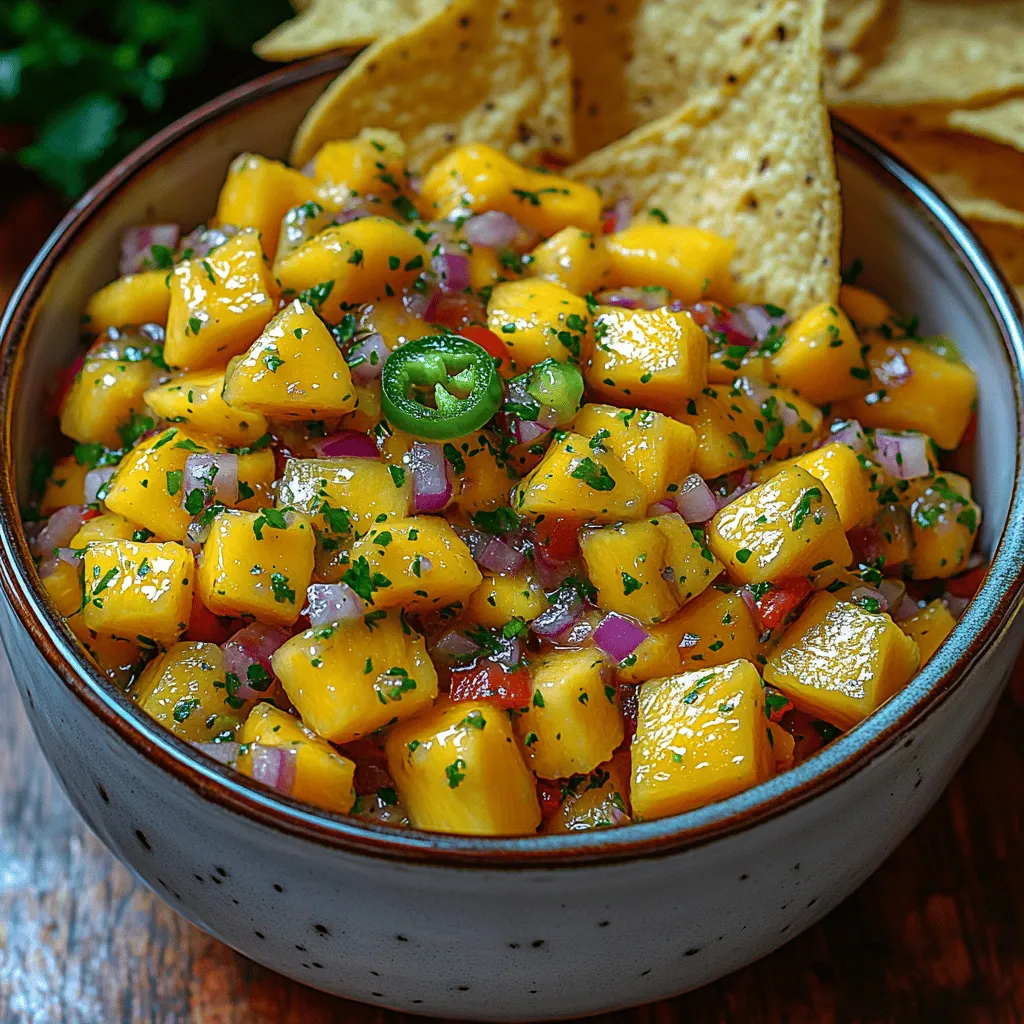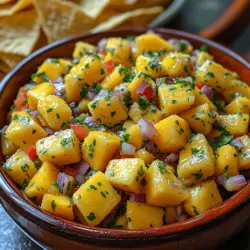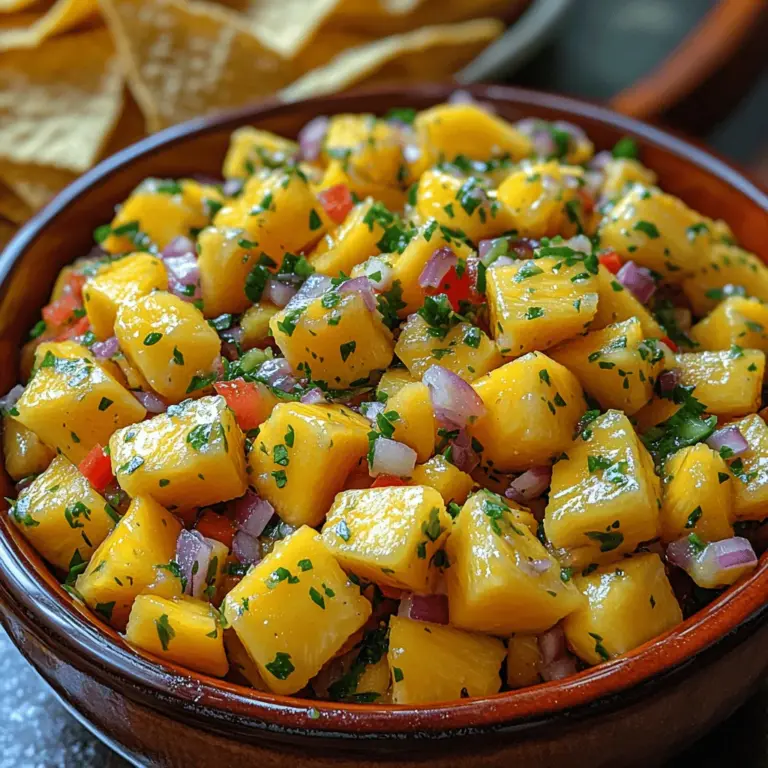Introduction to Tropical Tango Mango Pineapple Salsa
In the world of culinary delights, few dishes evoke the vibrant essence of summer quite like a refreshing salsa. Our recipe for Tropical Tango Mango Pineapple Salsa is a celebration of tropical flavors, bursting with freshness and zest. This salsa doesn’t just tantalize the taste buds but also transports you to sun-soaked beaches and swaying palm trees, making it the perfect accompaniment for any occasion. Whether you’re hosting a backyard barbecue, planning a festive gathering, or simply craving a healthy snack, this salsa serves as a delightful addition to a variety of dishes.
The appeal of this Tropical Tango Mango Pineapple Salsa lies not just in its lively colors and flavors but also in its versatility. Use it as a topping for grilled fish or chicken, a dip for tortilla chips, or even a zesty addition to tacos. The combination of sweet mango and pineapple, with a hint of heat from jalapeños and the brightness of lime juice, creates a balance that is both refreshing and satisfying. This salsa fits seamlessly into various culinary traditions, showcasing how simple ingredients can elevate a dish from ordinary to extraordinary.
Understanding the Ingredients
To create a truly exceptional salsa, quality ingredients are key. Each component of this Tropical Tango Salsa plays a crucial role in developing the overall flavor profile, texture, and aroma. Let’s explore the essential ingredients that make this salsa a standout.
Mango
At the heart of this salsa is the mango, a fruit celebrated not only for its luscious sweetness but also for its numerous health benefits. Rich in vitamins A and C, mangoes are known to support immune function and promote healthy skin. The flavor of a ripe mango is a perfect blend of sweetness with a hint of tartness, providing a delightful contrast to the other ingredients in the salsa. When selecting mangoes, look for those that yield slightly to pressure and emit a sweet fragrance, indicating ripeness.
Pineapple
Complementing the mango is the pineapple, another tropical fruit that adds a unique balance of sweetness and acidity. Pineapples are packed with bromelain, an enzyme known for its anti-inflammatory properties and digestive benefits. The bright, tangy flavor of fresh pineapple enhances the salsa’s overall freshness, making it a refreshing choice for warm weather. When choosing a pineapple, opt for one that is firm but slightly soft at the base, with a sweet aroma at the stem end.
Red Onion
Adding a satisfying crunch and a pop of color to the salsa is the red onion. Known for its milder taste compared to yellow or white onions, red onions provide a subtle sharpness that complements the sweetness of the fruits. Nutritionally, red onions are rich in antioxidants and vitamins, contributing to overall health. When diced, they not only bring texture but also enhance the visual appeal of the salsa with their vibrant purple hue.
Red Bell Pepper
The inclusion of red bell pepper introduces another layer of crunch and sweetness while also boosting the nutritional content of the salsa. Red bell peppers are high in vitamins A and C, along with various antioxidants. Their vibrant color not only enhances the presentation but also ensures a delightful balance of flavors. When diced, they provide a satisfying bite that pairs beautifully with the other ingredients.
Jalapeño
For those who enjoy a bit of heat, the jalapeño pepper adds just the right amount of spice to the salsa. You can easily customize the heat level by adjusting the amount of jalapeño used or by removing the seeds, which house the pepper’s spiciest oils. Jalapeños are also rich in vitamins A and C, making them a nutritious addition. When preparing jalapeños, it’s essential to handle them with care; using gloves can prevent the oils from irritating your skin.
Cilantro
Cilantro is often a polarizing herb, but when it comes to salsa, its fresh, herbal notes are indispensable. The bright, citrusy flavor of cilantro complements the tropical fruits and adds an aromatic quality to the dish. Nutritionally, cilantro is packed with antioxidants and has been linked to various health benefits, including anti-inflammatory properties. When chopping cilantro, aim for a fine mince to maximize its flavor distribution throughout the salsa.
Lime Juice
To tie all these flavors together, lime juice is a must. The acidity from lime juice brightens the salsa, enhancing the natural sweetness of the mango and pineapple. Limes are rich in vitamin C and provide a refreshing zest that elevates the entire dish. When juicing limes, rolling them on the countertop before cutting can help release more juice for maximum flavor.
Salt and Pepper
The final touch to any salsa is a pinch of salt and pepper. These seasonings enhance and balance the flavors, allowing each ingredient to shine. Salt brings out the sweetness of the fruits, while pepper adds a subtle warmth. Always adjust the seasoning to taste, keeping in mind that fresh ingredients can vary in flavor intensity.
Importance of Using Fresh, High-Quality Ingredients
The success of this Tropical Tango Mango Pineapple Salsa hinges on the quality of the ingredients used. Fresh, high-quality produce not only contributes to the flavor but also impacts the nutritional value of the dish. Sourcing ripe, organic fruits and vegetables whenever possible ensures that you’re not only making a delicious salsa but also one that is packed with nutrients. The freshness of the ingredients shines through, making each bite a vibrant explosion of flavor.
Preparation Steps for Tropical Tango Salsa
Now that we’ve explored the ingredients, it’s time to delve into the preparation of the Tropical Tango Mango Pineapple Salsa. Following a few essential steps will ensure that your salsa is not only delicious but also visually appealing.
Step 1: Gather Your Ingredients
Begin by assembling all your ingredients. You’ll need ripe mangoes, fresh pineapple, red onion, red bell pepper, jalapeño, cilantro, lime, salt, and pepper. Having everything at hand will streamline the preparation process and make it more enjoyable.
Step 2: Dice the Fruits and Vegetables
Start by peeling and dicing the mangoes and pineapple into small, uniform pieces. This helps create a consistent texture throughout the salsa. It’s recommended to use a sharp knife for clean cuts and to ensure safety during the dicing process.
For the red onion and red bell pepper, finely chop them into small pieces. The goal is to have all the ingredients roughly the same size to ensure that every bite contains a harmonious blend of flavors.
Step 3: Prepare the Jalapeño
When handling jalapeños, it’s important to work safely. If you prefer a milder salsa, consider removing the seeds and membranes, as they contain the most heat. Use a sharp knife to carefully slice the jalapeño in half lengthwise, then scoop out the seeds with a spoon. Finely chop the jalapeño, adjusting the amount used based on your spice preference. Remember to wash your hands thoroughly after handling jalapeños, or wear gloves to prevent any irritation.
Step 4: Combine the Ingredients
In a large mixing bowl, combine the diced mango, pineapple, red onion, red bell pepper, and jalapeño. Gently fold the ingredients together with a spatula, being careful not to mash the fruits.
Next, chop a handful of fresh cilantro and add it to the bowl, followed by the juice of one or two limes. Start with one lime and taste before adding more, as you want to achieve a balanced flavor profile. Season the salsa with salt and pepper, adjusting to your taste.
Step 5: Allow the Salsa to Rest
For the best flavor, let the salsa rest for at least 15-30 minutes before serving. This allows the ingredients to meld together, creating a more cohesive taste. During this time, the flavors will develop and deepen, resulting in a salsa that is bursting with tropical goodness.
With these steps, you’re well on your way to creating a delicious Tropical Tango Mango Pineapple Salsa that will impress your family and friends alike. The combination of fresh ingredients, vibrant flavors, and the simple preparation process makes this salsa a must-try in your kitchen.
Stay tuned for the next part of this article, where we will delve deeper into flavor profiling and balancing in salsa, ensuring that your Tropical Tango experience is nothing short of exceptional.

The Balance of Sweetness, Acidity, and Heat
Creating a truly exceptional Tropical Tango Mango Pineapple Salsa hinges on achieving the perfect balance among sweetness, acidity, and heat. The mango and pineapple provide natural sweetness that forms the foundation of this salsa, while lime juice introduces a refreshing acidity that brightens the flavors. The addition of jalapeño or other chili peppers brings a subtle heat, enhancing the overall taste without overpowering the sweetness of the fruits.
To achieve this balance, it’s essential to taste as you go. Start with small amounts of lime juice and jalapeño, adjusting gradually to suit your palate. If the salsa leans too sweet, add a bit more lime juice; if it lacks warmth, incorporate additional chili. This iterative process not only perfects the flavor profile but also engages your senses, making the preparation of this salsa a delightful experience.
Understanding the Marination Process
One of the key elements of making an outstanding salsa is understanding the marination process. When the salsa ingredients are combined, the flavors begin to meld. The salt draws moisture from the fruits and vegetables, allowing the juices to mix and create a flavorful brine. This process not only enhances the flavor of each component but also softens the ingredients slightly, making them more palatable.
As the salsa sits, the different flavors—sweet, spicy, and tangy—interact, creating a harmonious blend that is greater than the sum of its parts. The marination process is essential for allowing the ingredients to marry, resulting in a salsa that is bursting with flavor.
Why Resting the Salsa Enhances Flavor
Resting the salsa is a crucial step that shouldn’t be overlooked. When you allow the salsa to rest, it gives the ingredients time to absorb the flavors of the lime juice and other seasonings. This resting period allows for a more cohesive taste experience, where the sweetness of the mango and pineapple, the tanginess of the lime, and the heat from the jalapeño come together beautifully.
Moreover, during this time, the natural sugars in the fruits can mellow, creating a more balanced flavor profile. The resting period also allows any sharpness from the onions or garlic to soften, resulting in a smoother taste.
Ideal Resting Time for Optimal Taste
For the best results, let your Tropical Tango Mango Pineapple Salsa rest for at least 30 minutes before serving. This duration provides ample time for the flavors to meld and develop. However, for an even richer taste, consider refrigerating the salsa for 1-2 hours. If you have the time, preparing the salsa a few hours in advance or even the night before will elevate the flavor profile significantly.
Serving Suggestions and Pairings
Tropical Tango Mango Pineapple Salsa is incredibly versatile and can be enjoyed in various ways. Here are some creative serving suggestions that will enhance your culinary experience:
As an Appetizer with Tortilla Chips
One of the simplest and most popular ways to serve this salsa is as an appetizer alongside crispy tortilla chips. The crunchiness of the chips perfectly complements the fresh, juicy salsa, creating a delightful contrast in texture. For an extra touch, consider making homemade tortilla chips by frying or baking corn tortillas until crisp. Serve the salsa in a colorful bowl, garnished with fresh cilantro for an inviting presentation.
As a Topping for Grilled Meats or Fish
Tropical Tango Mango Pineapple Salsa makes an excellent topping for grilled meats or fish, adding a burst of flavor to your dishes. Try spooning it over grilled chicken, pork, or fish such as salmon or mahi-mahi. The sweetness of the salsa pairs wonderfully with the smoky, charred flavors from the grill, enhancing your meal’s overall appeal. For a complete dish, serve it alongside rice or quinoa.
Ideas for Incorporating Salsa into Other Dishes
Think beyond the traditional uses of salsa by incorporating it into other dishes. Consider adding it to tacos, where it can complement shredded chicken, beef, or black beans. Mix it into a green salad for a refreshing twist or use it as a topping for avocado toast for a vibrant breakfast option. The possibilities are endless, and experimenting with different combinations can lead to exciting new meals.
Visual Presentation Tips for an Appealing Dish
To ensure your Tropical Tango Mango Pineapple Salsa is as visually appealing as it is delicious, consider the following presentation tips:
– Use a clear glass bowl to showcase the vibrant colors of the salsa.
– Garnish with fresh herbs, such as cilantro or mint, for a pop of green.
– Serve with colorful plates or platters to enhance the visual appeal of your meal.
– Consider layering the salsa with other ingredients, such as avocado or black beans, for an attractive, multi-textured display.
Nutritional Analysis of the Salsa
Understanding the nutritional content of your Tropical Tango Mango Pineapple Salsa can help you appreciate its health benefits. Here’s a breakdown of key components:
– Mango: High in vitamins A and C, mangoes are rich in antioxidants and beneficial for eye health and immune function.
– Pineapple: Packed with vitamin C and manganese, pineapple also contains bromelain, an enzyme that aids digestion.
– Jalapeño: This chili pepper is low in calories and rich in vitamins A and C, along with capsaicin, known for its anti-inflammatory properties.
– Red onion: Provides antioxidants and is a good source of vitamins C and B6, as well as folic acid.
– Lime juice: A low-calorie ingredient, lime juice is an excellent source of vitamin C and can help enhance iron absorption from other foods.
The entire salsa recipe is relatively low in calories, making it a healthy addition to any meal. It’s also vegan and gluten-free, catering to a variety of dietary preferences.
Cultural Significance of Salsa in Culinary Traditions
Salsa holds a special place in Latin American cuisine, with a rich history that dates back centuries. The word “salsa” itself means “sauce” in Spanish, and it encompasses a wide variety of sauces used to enhance the flavors of dishes. Traditional salsas often feature tomatoes, chilies, onions, and herbs, showcasing the diverse ingredients available in the region.
Over time, the evolution of salsa recipes has seen the introduction of various fruits, vegetables, and spices, leading to the creation of countless variations. Tropical Tango Mango Pineapple Salsa is a modern twist on this classic, reflecting contemporary dining trends that favor fresh, bold flavors and vibrant colors.
In today’s culinary world, salsa has transcended its traditional roots, becoming a beloved accompaniment in many cuisines. The popularity of fruity salsas, like the Tropical Tango variety, highlights the global embrace of fresh ingredients and the desire for healthier, flavorful options.
Conclusion
In summary, Tropical Tango Mango Pineapple Salsa is a delightful exploration of flavors that balances sweetness, acidity, and heat. Its vibrant colors and fresh ingredients make it an appealing addition to any meal, whether served as an appetizer, topping, or integral component of a broader dish. With its health benefits and versatility, this salsa fits perfectly into modern dining trends while paying homage to its Latin American roots.
We encourage you to experiment with this refreshing salsa at home, adjusting the ingredients to suit your taste. Embrace the freshness and creativity that comes with making your own salsa, and enjoy the burst of tropical flavors it brings to your dishes. Whether you’re hosting a gathering or simply looking to enhance your everyday meals, Tropical Tango Mango Pineapple Salsa is sure to impress and satisfy.


